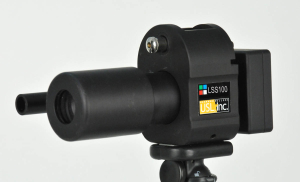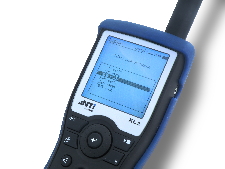Laser Light Engines Announces First Shipment of Its Universal Laser Retrofit System for 2D and 3D Digital Cinema
SALEM, NH– May 22, 2013 –
Jeez, just the heading. “Universal” must mean One Product fits all. That ties into the other press release LLE had on the same day, that they will be teaming with Elbit Systems of Texas to productize a system with the name of DSG265. We’re guessing DSG is for De-Speckled Green, but 265 stumps us. 256 we could have understood if this were an 8 bit system, or 255 perhaps…but DCinema is 12 bit. Hmmm. Marketing.
“Retrofit” is interesting as well. The concept of productizing anything for a market that is essentially completely full – over 90% digital saturation in some markets – there just isn’t going to be a lot of customers looking to trade-in for new projectors. There also isn’t an overwhelming reason to do so since many of the future options of lasers for projectors aren’t developed yet. Plugging into the existing optics works well enough until the mysteries of bi-refringent glass and spinning the photons off the mirrors solves the problems of darkening and softening caused by post-lens 3D filters. So, expensive ultra fast lenses and a lot of optics (that the next generation of engineers will laugh at) will have to remain – retrofit is the way to make the investment in the laser-based light systems work in 2013.
“2D and 3D Cinema” – To those who say that 3D is dead or dying, let’s remember that the studio’s latest arrangements with the Chinese government is to bring the tentpole movies in 3D…not just some, but 100% in 3D. Most of the cinema conversions are 3D capable there, and the 3D-capable percentage in Russia and parts of the EU are higher than in the US as well.
But 3D to work correctly needs more light to the eyes. There are few articles and only a little science on what causes headaches and other problems with 3D, but from those who have seen 3D movies with more light, it is more comfortable. Logic says that more light will make tired eyes strain less with a concommittant reduction in headaches and complaints.
“Announces the First Shipment” – has a nice ring to it after all the speculation and probable NIH competition since LLE made their despeckle announcement a few CinemaCons ago. It seemed obvious to many that the Kodak flash was never going to be productized, and possibly was a stock play writ large. But an actual shipment…and to whom? Enquiring minds, etc.
Having to wait for the lawyers and the marketing team of the customer can be a boring proposition for a company, especially one which wants to avoid the arrows (and worse) that many pioneers have to suffer.
Laser Light Engines, Inc., (LLE), a leader in laser illumination for high brightness digital cinema and performance projection, announced the first shipment of a fully configured RGB-laser powered Universal Laser Retrofit System to a leading global innovator in the cinema space.
“Leading Global Innovator” – Isn’t that a nice way of saying that they are smart enough to buy our product?
“The shipment of this system marks a big step forward for LLE, toward full commercialization of our universal laser upgrade solution for the nearly 100,000 global 2D and 3D digital cinema projectors installed over the past few years,” said laser projection pioneer Bill Beck, founder and EVP at LLE. According to the company, the multi-engine system incorporates LLE’s recently announced, flagship DSG265™ despeckled GREEN color modules, and provides constant brightness, outstanding image quality, brilliant colors and smooth, immersive 3D.
One would think at first that Mr. Beck was hyperbolizing a bit there, implying that 100,000 is the potential market for LLE’s light engine. In fact, in a sense he probably is, but in a sense he is probably understating the potential. There are 4 DCinema projector manufacturers who all sell projectors in far greater volume outside the cinema. They are joined by dozens of other manufacturers who use the same TI chipset (minus the security bits) for other than cinema projectors. Given the way that 3D is developing and getting less expensive on the production and post-production side, creation of 3D material can slip into many more markets, from architecture and product design to executive or music auditoriums to amusement rides.
Productizing is the key, and the market is really huge.
In addition to providing numerous image quality benefits, the LLE solution eliminates frequent replacement of expensive Xenon arc lamps, and can reduce wall plug and HVAC energy consumption. “The LLE multi-engine system is projector, chipset, resolution and frame rate agnostic, and is compatible with most major 3D systems,” Beck said. “And the light from the engine can be delivered via optical fiber cable, enabling flexible new cost- and space-saving deployment models.”
What isn’t being said is almost as loud as what was said in that paragraph. The discussions at recent demonstrations left one with the impression that some companies are not actually able to move the laser position on the frequency curve in a way that benefits both the gamut but also the wall plug efficiency, actually saying that their system wasn’t showing any benefit there, and that the cost of fans at the lasers was a wash with the reduction of savings at the projector vent. One presumes that one is hearing someone saying that the brute force method is all we can do and it works but it doesn’t work well…and come’on, the music moves the screen more than these screen shakers do.
It is just that one can’t help remembering the earthquake in the San Fernando Valley in 1994 when two earthquakes happened in close time and proximity. The joining of the concentric waves caused a much stronger reaction in a nearly straight line from the source points to dozens of miles away, to the extent of chimneys falling and houses being thrown off their foundations all along and to the end of that line, with much less severe damage a block away on either side.
Likewise, the patterns from the shakers was discernible after two weeks, with the light changing colors all along the path where concentric circles joined. Dont’ get the wrong impression; it was a brave and noble act to hold a 2 week demonstration of laser technology. Christie and their parent company Ushio should be lauded. The industry needed it. There is only one way to learn such things and groups should be given honors for taking the expense and the risk.
“Frame rate agnostic” means the future of High Frame Rate is secured and the rest of the PR is stating that compromises no longer have to be made. If history is a guide, the studios allow compromises with specifications until a manufacturer shows that the compromise is no longer required and then sets a date certain for not making prints in that format. MPEG to JPEG, the evolution of security keys and the disappearance of pre-ghostbusted prints all followed that path: one day accepted, one day ‘no mas’.
Resolution agnostic is interesting since it implies 4K, and sure enough – though it isn’t in this press release – if one goes to the LLE website and clicks on the coming event link on
June 11, 2013, 5:00pm
“Laser6P™: A New Laser Illumination System for Premium Dual Projector 3D”
Projection Summit
Orlando, FL
one sees in plain black and white that Mr. Beck of LLE will speak about “LLE was the first to demonstrate laser illuminated, “6 primary”, true 4K 3D with full color and resolution in November of 2012. Both DLP Cinema and LCOS 4K projector platforms have been integrated.”
As exciting as seeing the new RealD screen technologies in action with multiple screens at different angles and light levels, seeing any of the matrix of what that sentence speaks of would be very interesting. The implication is that others have already seen it in private demonstrations, since the verbiage says ‘already been demonstrated’.
In addition to this major milestone for digital cinema, Beck said LLE will be shipping other new products in the coming months, including both cinema and non-cinema applications such as precision 3D metrology.
“Precision 3D metrology” – We haven’t yet seen anything of the industry’s attempt to create a precision metrology on speckle (or when the distortion goes from bad to unacceptable) and these guys are making products dealing with the measurement of 3D. Wonders never cease.
About Laser Light Engines — Laser Light Engines, Inc. (LLE) is a leader in laser illumination for performance projection, such as 3D cinema; premium large venue and rental/staging. LLE’s laser illumination systems replace traditional, high-pressure gas discharge lamps, producing dramatically brighter and sharper images, with less energy use and lower operating costs. LLE’s universal engine can plug and play with new projection systems or retrofit tens of thousands of installations, worldwide.
Partnerships with key industry players, a portfolio of patented technology and expertise, and a multi-year head start in building laser illumination systems, all combine to make LLE the leader in this large and rapidly emerging market. The venture-funded company was founded in 2008 and is headquartered in Salem, New Hampshire, USA. For additional information visit: http://www.laserlightengines.com Laser Light Engines, LLE, DSG265 and Laser6P are trademarks of Laser Light Engines, Inc. All other trademarks and registered trademarks are the property of their respective holders.
Boilerplate. Wish I had some. But actually, there is data in there. The beauty of boilerplate is that it is all lawyer vetted, so yes Alice, someone is thinking beyond retrofit and those lawyers are sure there is lower operating costs and less energy use in our future all from replacing xenon lamps with laser light.

